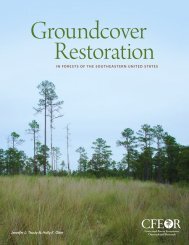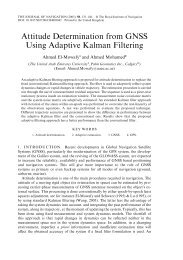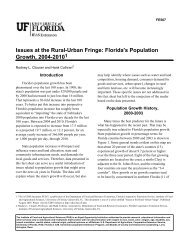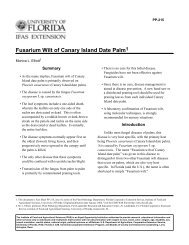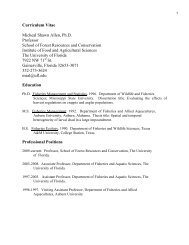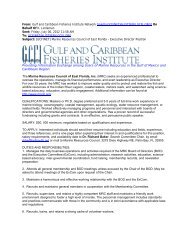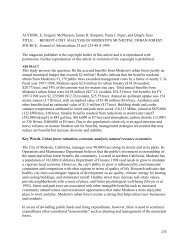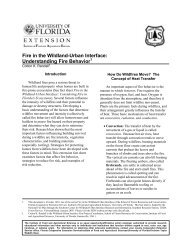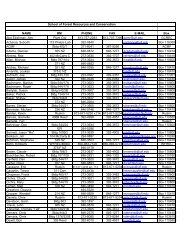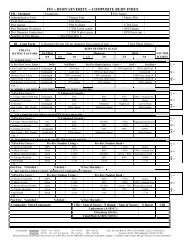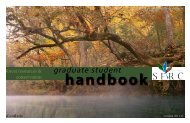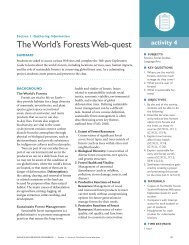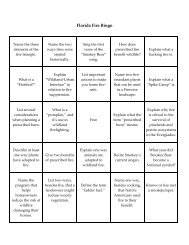Longleaf Pine Forest Restoration & Management - School of Forest ...
Longleaf Pine Forest Restoration & Management - School of Forest ...
Longleaf Pine Forest Restoration & Management - School of Forest ...
You also want an ePaper? Increase the reach of your titles
YUMPU automatically turns print PDFs into web optimized ePapers that Google loves.
Prescribed Burning Regulations in Florida 4<br />
A "certified prescribed burn manager" is an<br />
individual who successfully completes the DOF<br />
certification program and possesses a valid<br />
certification number. The certification program<br />
includes either a correspondence course or one-week<br />
training course, direct experience managing or<br />
helping conduct at least three prescribed burns, and<br />
recertification every five years. Certification renewal<br />
requires a minimum <strong>of</strong> eight hours <strong>of</strong> training and use<br />
<strong>of</strong> the certified burner's number on at least two burns.<br />
A certified prescribed fire that meets all the<br />
requirements described in FS 590.125 is considered<br />
to be in the public interest and a right <strong>of</strong> the property<br />
owner. Under the 1999 legislation, "a property owner<br />
or his or her agent is neither liable for damage or<br />
injury caused by the fire or resulting smoke ...for<br />
(certified) burns conducted in accordance with this<br />
subsection unless gross negligence is proven." The<br />
"gross negligence" condition provides substantially<br />
more protection to landowners and certified burners<br />
than under previous law. A certified burner who<br />
violates any <strong>of</strong> the requirements commits a<br />
second-degree misdemeanor.<br />
Administrative Rules for Prescribed<br />
Burning<br />
To comply with the 1999 statute changes, the<br />
Florida Administrative Code was also revised.<br />
Important rules (see Chapter 5I-2, F.A.C.) for<br />
prescribed burning include the following:<br />
1. Daytime burning authorizations are issued for<br />
9:00 a.m. to one hour before sunset for<br />
noncertified burners and to one hour after sunset<br />
for certified burners.<br />
2. Nighttime authorizations are issued for one hour<br />
before sunset to 9:00 a.m., under dispersion<br />
indices <strong>of</strong> 8 or higher and 6 or higher for<br />
noncertified and certified burners, respectively.<br />
3. Certified burners must present their number at<br />
the time <strong>of</strong> their permit request, and they must<br />
have a copy <strong>of</strong> the prescription on site for<br />
inspection.<br />
4. Minimum requirements for the prescription<br />
include: stand, site and fuel description; map <strong>of</strong><br />
the area to be burned; personnel and equipment<br />
to be used; desired weather factors; desired fire<br />
behavior; ignition technique; time and date the<br />
prescription was prepared; authorization date and<br />
time period; an evaluation and approval <strong>of</strong> the<br />
anticipated impact <strong>of</strong> the proposed burn on<br />
smoke-sensitive areas; and signature and number<br />
<strong>of</strong> the certified burn manager. (Prescriptions are<br />
not required for fires managed by non-certified<br />
burners, but are highly recommended for<br />
planning and control purposes).<br />
5. Piles or windrows must be at least 100 feet from<br />
paved, public highways; they can have no visible<br />
flame one hour before sunset or thereafter; and<br />
wind direction must carry smoke from them<br />
away from public roads.<br />
6. Open burning is not allowed:<br />
• when the fire may pose a threat to public<br />
health, safety, and property protection;<br />
• in smoke-sensitive areas between one hour<br />
before sunset and 9:00 a.m.;<br />
• when visibility on public roads would be<br />
reduced to less than 1,000 feet;<br />
• if it reduces visibility at a public airport;<br />
• during air quality or stagnation<br />
advisories.<br />
Local Ordinances<br />
Local legislation (city or county) can be more<br />
restrictive than state and federal rules, but not in<br />
conflict with them. For example, you are required to<br />
obtain a permit from the Florida DOF to be legal for<br />
any prescribed fire or other open burning. However,<br />
you may also be required to obtain a permit from<br />
your local governing authority to be compliant with<br />
local ordinances. It is the responsibility <strong>of</strong> prescribed<br />
burners to make themselves aware <strong>of</strong> any applicable<br />
local regulations regarding burning permits.<br />
Silviculture Best <strong>Management</strong><br />
Practices (BMPs)<br />
The 2000 BMPs are intended for implementation<br />
on all silviculture operations (which may include



